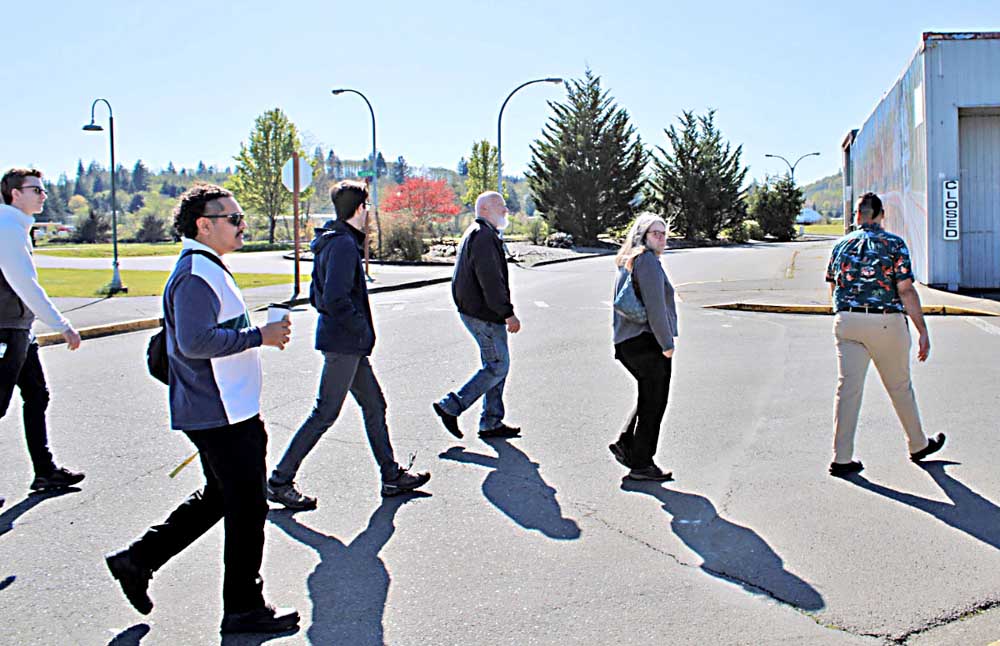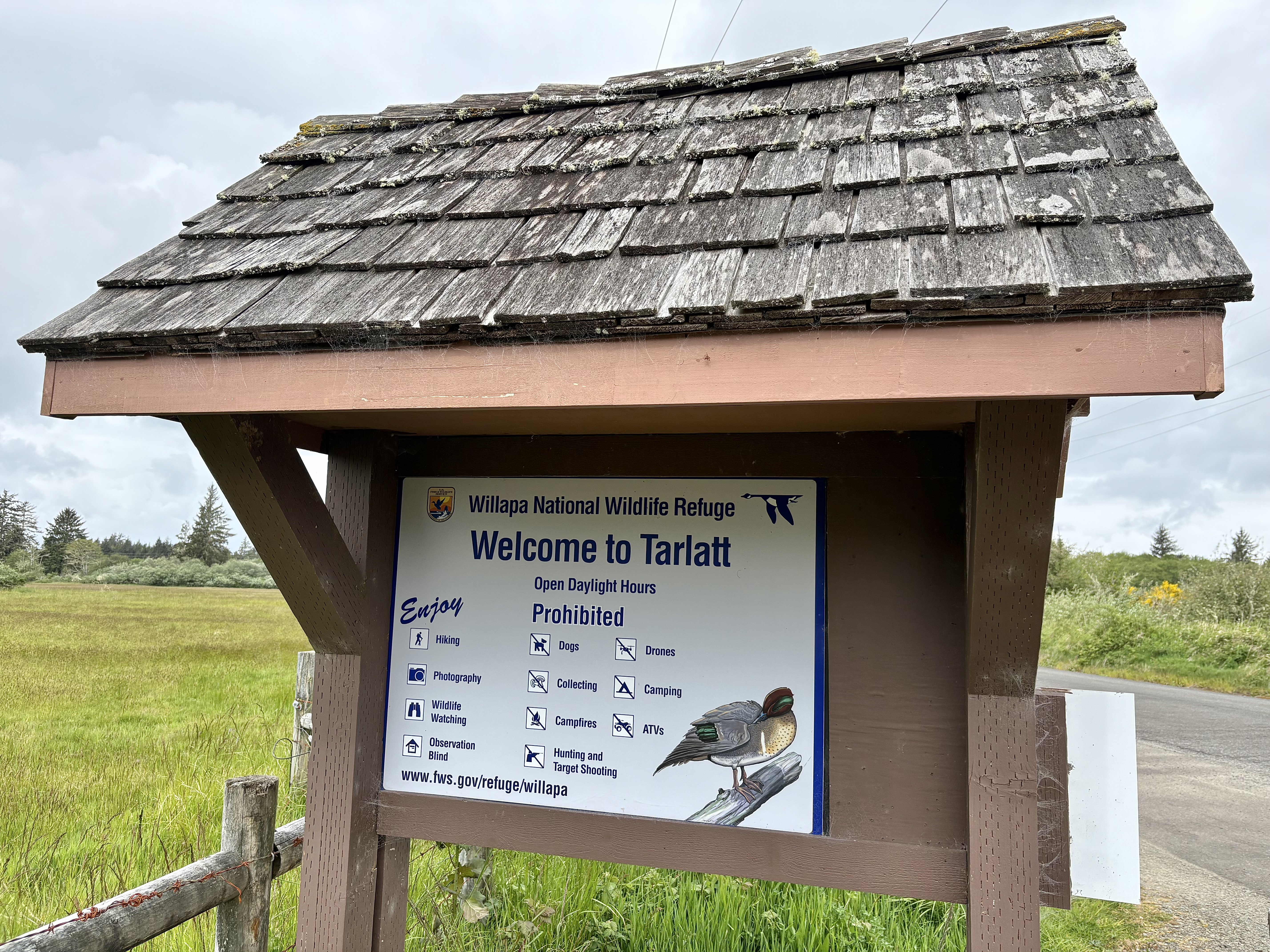Plugging into future EV growth: Few public charging stations available as demand grows
Published 9:53 am Monday, July 1, 2024

- University of Washington graduate students visited Pacific County this spring as part of their work on a report aimed at making recommendations for how, and where, the county could build up its electric vehicle charging infrastructure to meet current and future demand. Also pictured is county planning commissioner and consultant Kelly Rupp, third from right, and Pacific County Economic Development Council Executive Director Sue Yirku, second from right.
PACIFIC COUNTY — Graduate students with the University of Washington’s architecture and urban planning school have made recommendations and identified potential locations for Pacific County to build up its electric vehicle charging infrastructure to meet future — and existing — demand in a report released last month.
Trending
The 68-page report from students in UW’s College of Built Environments comes via a partnership between the university’s Livable City Year program and the Pacific County Economic Development Council. Originally slated to cover only the 2022-23 academic year, the partnership between UW and the EDC was extended into 2023-24 to tackle a handful of additional projects relating to housing and transportation.
The report includes a 10-year phased plan to build out EV charging infrastructure along U.S. 101 within the county and recommends specific sites where charging stations can be built over that period.
The report includes a 10-year phased plan to build out EV charging infrastructure along U.S. 101 within the county and recommends specific sites where charging stations can be built over that period.
Trending
The group interviewed a number of local stakeholders for their report, including Long Beach Mayor Sue Svendsen, Long Beach City Administrator David Glasson, Ilwaco City Administrator Holly Beller, Port of Ilwaco Manager Tracy Lofstrom, Pacific County PUD No. 2 General Manager Marc Wilson, Willapa Bay Enterprises COO Jesse Downs and Adrift Hospitality CEO Tiffany Turner.
Along with a general lack of funding, the students found during their interviews that power availability is a major concern when it comes to evaluating charging station locations, although PUD officials “were clear that there is more than enough power available in Pacific County.”
“Every interview subject expressed excitement about the prospect of EVs and believed that developing EV charging infrastructure was a positive step,” the report states. “This motivation and optimism plays a crucial role in the project to expand EV infrastructure in Pacific County. It will facilitate the collaboration between site hosts, municipalities and other parties necessary to advance the project.”
Lacking infrastructure
There are currently just 12 non-residential EV charging stations that are Level II or above in the entire county, and only four of the chargers are readily open to the public — the others are reserved for hotel guests and local business customers.
Level I chargers are primarily used for residential charging, and take 40-50 hours to charge an electric vehicle from empty. Level II chargers are used both residentially and for public use, and take 4-10 hours to fully charge an EV. Depending on the age of the model, direct current (DC) fast chargers can take as little as 20 minutes to charge an EV to 80%.
Charging stations, particularly the newest models, don’t come cheap. Equipment costs for four state-of-the-art DC fast chargers carry an estimated cost of $650,000, while the projected installation cost is $465,000. The team of UW students said grants, particularly from a variety of state EV grant programs, “offer a prime opportunity for funding charging infrastructure.”
The Federal Highway Administration has identified U.S. Highway 101 as a potential Alternative Fuel Corridor, which opens up federal funding to support the installation of EV infrastructure along the highway. Earlier this year, Energy Northwest received nearly $15 million through a federal program to develop more than 50 chargers across 12 charging locations along U.S. 101 in western Washington and coastal Oregon, including two charging stations in Ilwaco and Raymond that will contain six DC fast charging ports each.
A map of proposed site locations for charging locations from the Southwest Regional Transportation Planning Organization proposed 13 new Level II stations across Pacific County, which would more than double the number of charging stations in the county.
A needs assessment conducted by the graduate students projected that more than 20% of all cars visiting the county in 2034 will be EVs. By that time, the group estimates that 110 Level II and 16 DC fast charging stations will need to be built in Long Beach and Ilwaco to keep up with demand, along with 28 Level II and 12 DC fast charging stations in Raymond and South Bend.
According to estimates from Kelley Blue Book, nearly 1.2 million new EVs were sold in the U.S. in 2023 — 7.6% of the national vehicle market, up from 5.9% the year prior. Data from the Washington State Department of Licensing shows there were more than 191,000 registered EVs in the state as of this May, nearly double the 98,631 registered in May 2022.
Identifying locations, opportunities
The team identified 35 potential locations where public chargers could be installed through a mix of visiting sites and receiving suggestions from stakeholders, community members and government officials.
Each of the locations were scored based on half a dozen factors, such as how well the layout of the lot can accommodate charging, restroom access and nearby businesses and visitor attractions — the latter of which are particularly important for Level II charging stations, which usually take several hours to charge most vehicles.
On the peninsula, locations include the Port of Ilwaco, Ilwaco City Hall, Long Beach’s public parking lots along Oregon Avenue South, Bolstad Avenue West, the Bay Avenue beach approach in Ocean Park and the Ocean Park Library. Other locations in south county include the Port of Chinook and the Naselle Clinic.
The report also details how the charging stations can be configured to be compliant with the Americans with Disabilities Act — charging stations are often sited and planned with state or federal funding, which usually require adherence to ADA standards — as well as being paired with activities that can occupy users for the time it takes for their EV to be charged.
“The best charging stations offer as many services and amenities as possible within walking distance to users,” the report states. “Stations should also be designed to provide protection from the elements and contribute positively to their local environment by managing runoff and including trash receptacles to prevent littering.
“Ultimately, however, station elements will have to be weighed to reconcile budgets. Thus, the minimum standard should be ADA accessibility and at least one nearby amenity that corresponds to the charging duration.”
The average construction time for one EV charging station is two or more years, from site assessment to final installation and operation. Unpredictable factors like supply chain delays can also impact the construction timeline, but there are also opportunities to cut time and costs, such as by using the same site design and simultaneously building multiple stations on the same site.
Opportunities to speed up the process include streamlining the permitting timeline by creating a standardized permit review process, simplifying the review and approval process and establishing an online permitting platform. The team also suggested updating local ordinances, such as allowing EV charging spaces to count toward minimum parking requirements — something the city of Walla Walla did more than a decade ago.
Other recommendations include having the county encourage or require developers to install conduits in new parking lots or structures to reduce the cost of EV charging station projects in the future, as well as adopting an evaluation protocol to monitor EV network progress that can provide valuable evidence and data for future grant and funding applications.
A summary of the report, along with a map of proposed sites, can be viewed at https://arcg.is/19bK1i1.









